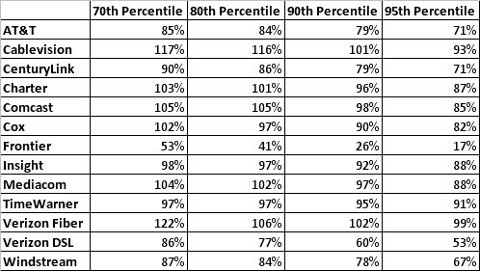Lies, damned lies, and Internet speeds


ISPs have a bad habit of promising to deliver Internet speeds they actually can't deliver. But, according to the U.S.'s Federal Communication Commission (FCC) latest ISP Internet report, Measuring Broadband America, A Report on Consumer Wireline Broadband Performance in the U.S. ISPs are getting better at residential Internet broadband.
The FCC found that “participating broadband providers, actual download and upload speeds were over 80 percent of advertised speeds.” Just over 80% is a C in my school, but the ISPs are doing much better than they were last year. “In 2011, the average ISP delivered 87 percent of advertised download speed during peak usage periods [weeknights between 7:00 pm to 11:00 pm local time]; in 2012, that jumped to 96 percent. In other words, consumers today are experiencing performance more closely aligned with what is advertised than they experienced one year ago.”
The researchers also found that the “Average peak period download speeds varied from a high of 120 percent of advertised speed to a low of 77 percent of advertised speed. This is a dramatic improvement from last year where these numbers ranged from a high of 114 percent to a low of 54 percent.”
Five ISPs routinely met or exceeded their sustained advertised peak download rates. These were, from highest to lowest: Verizon Fiber), Cablevision, Comcast, Mediacom, and Charter. The worse, and it was by a wide margin, was Frontier.
That said, the FCC also found that “differences among ISPs in their ability to deliver advertised speeds are now smaller” than they were last year. “The average peak period download speeds varied from a high of 120 percent of advertised speed to a low of 77 percent of advertised speed. This is a dramatic improvement from last year where these numbers ranged from a high of 114 percent to a low of 54 percent.”
As far as the technologies behind your Internet connection are concerned, fiber is without any doubt that the best connection is fiber.. “On average, during peak periods DSL-based services delivered download speeds that were 84 percent of advertised speeds, cable-based services delivered 99 percent of advertised speeds, and fiber-to-the-home services delivered 117 percent of advertised speeds.”
Peak uploads speeds, with the exception of WindStream, “were 95 percent or better of advertised speeds. On average, across all ISPs, upload speed was 107 percent of advertised speed.”
While network speeds, and ISP's speed claims have improved significantly, one critical factor in Internet performance have improved only slightly. Latency, the time it takes for a data packet to travel from one point to another has remained “largely unchanged from last year.” That's no surprise though because “it primarily depends upon factors intrinsic to a specific architecture and is largely outside the scope of improvement if networks are appropriately engineered. In 2012, across all technologies, latency averaged 31 milliseconds (ms), as opposed to 33 ms measured in 2011.”
As traffic increases during peak usage times, latency also increases. “During peak periods, latency increased across all technologies by 6.5 percent, which represents a modest drop in performance. In 2011 this figure was 8.7 percent.”
As you might guess, fiber is once against the best technology when it comes to dealing with latency. “Fiber-to-the-home services provided 18 ms round-trip latency on average, while cable-based services averaged 26 ms, and DSL-based services averaged 43 ms.”
All these results are a national average. Your results will vary depending on your distance from your ISP, the age of the technology in your area, and other factors. To check our your personal ISP connection, run the tests I recommend in How to check on your Internet connection.
For the best home wired Internet service though it's clear that you want to get fiber first, followed by cable, and finally DSL.
Related Stories:
Windows 8 moves to IPv6 Internet
Crazy time to launch an ISP?
330Mbps fiber: coming soon from British ISPs
Cablevision slaps Verizon with lawsuit over Internet speed claims
How to check on your Internet connection